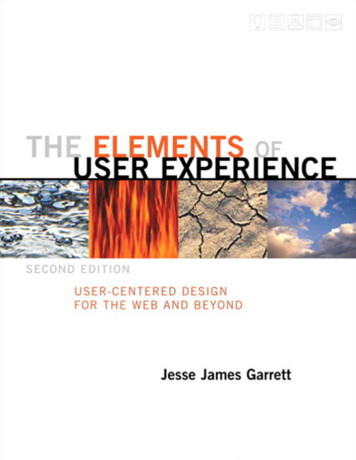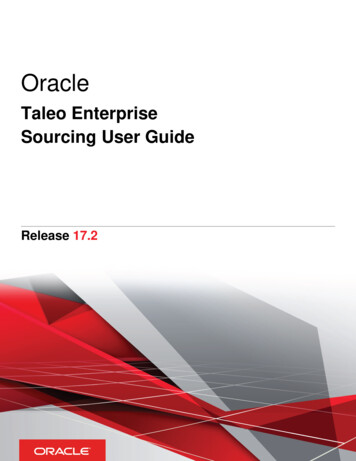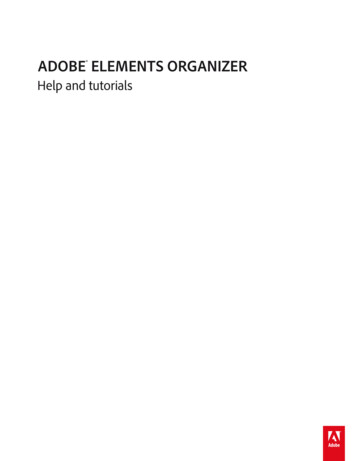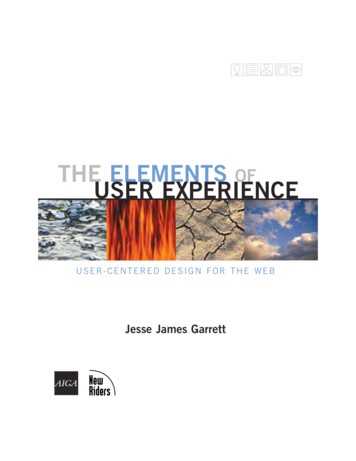
Transcription
The Elements of User Experience: User-Centered Design for the Web and Beyond,Second EditionJesse James GarrettNew Riders1249 Eighth StreetBerkeley, CA 94710510/524-2178510/524-2221 (fax)Find us on the Web at: www.newriders.comTo report errors, please send a note to errata@peachpit.comNew Riders is an imprint of Peachpit, a division of Pearson Education.Copyright 2011 by Jesse James GarrettProject Editor: Michael J. NolanDevelopment Editor: Rose WeisburdProduction Editor: Tracey CroomCopyeditor: Doug AdriansonProofreader: Gretchen DykstraIndexer: Valerie PerryCover Designer: Aren Howell StraigerInterior Designer: Kim ScottCompositor: Kim ScottNotice of RightsAll rights reserved. No part of this book may be reproduced or transmitted in any form byany means, electronic, mechanical, photocopying, recording, or otherwise, without the priorwritten permission of the publisher. For information on getting permission for reprints andexcerpts, contact permissions@peachpit.com.Notice of LiabilityThe information in this book is distributed on an “As Is” basis without warranty. While everyprecaution has been taken in the preparation of the book, neither the author nor Peachpit shallhave any liability to any person or entity with respect to any loss or damage caused or allegedto be caused directly or indirectly by the instructions contained in this book or by the computersoftware and hardware products described in it.TrademarksMany of the designations used by manufacturers and sellers to distinguish their products areclaimed as trademarks. Where those designations appear in this book, and Peachpit was awareof a trademark claim, the designations appear as requested by the owner of the trademark.All other product names and services identified throughout this book are used in editorialfashion only and for the benefit of such companies with no intention of infringement of thetrademark. No such use, or the use of any trade name, is intended to convey endorsement orother affiliation with this book.ISBN 13: 978-0-321-68368-7ISBN 10: 0-321-68368-4987654321Printed and bound in the United States of America
For my wife, Rebecca Blood Garrett,who makes all things possible.
ivTHE ELEMENTS OF USER EXPERIENCETable of ContentsCHAPTER 1User Experience and Why It Matters2Everyday Miseries3Introducing User Experience4From Product Design to User Experience Design7Designing (for) Experience: Use Matters8User Experience and the Web9Good User Experience Is Good Business12Minding Your Users17CHAPTER 2Meet the Elements18The Five PlanesThe Surface PlaneThe Skeleton PlaneThe Structure PlaneThe Scope PlaneThe Strategy Plane192020202121Building from Bottom to Top21A Basic Duality25The Elements of User ExperienceThe Strategy PlaneThe Scope PlaneThe Structure PlaneThe Skeleton PlaneThe Surface Plane282829303030Using the Elements31
THE ELEMENTS OF USER EXPERIENCEvCHAPTER 3The Strategy PlaneProduct Objectives and User Needs34Defining the Strategy36Product ObjectivesBusiness GoalsBrand IdentitySuccess Metrics37373839User NeedsUser SegmentationUsability and User ResearchCreating Personas42424649Team Roles and Process52CHAPTER 4The Scope PlaneFunctional Specifications and Content Requirements56Defining the ScopeReason #1: So You Know WhatYou’re BuildingReason #2: So You Know WhatYou’re Not Building58Functionality and Content61Defining Requirements65Functional SpecificationsWriting It Down6869Content Requirements71Prioritizing Requirements745960
viTHE ELEMENTS OF USER EXPERIENCECHAPTER 5The Structure PlaneInteraction Design and Information Architecture78Defining the Structure80Interaction DesignConceptual ModelsError Handling818386Information ArchitectureStructuring ContentArchitectural ApproachesOrganizing PrinciplesLanguage and Metadata8889929698Team Roles and Process101CHAPTER 6The Skeleton PlaneInterface Design, Navigation Design,and Information Design106Defining the Skeleton108Convention and Metaphor110Interface Design114Navigation Design118Information DesignWayfinding124127Wireframes128
THE ELEMENTS OF USER EXPERIENCEviiCHAPTER 7The Surface PlaneSensory Design132Defining the Surface134Making Sense of the SensesSmell and TasteTouchHearingVision135135135136136Follow the Eye137Contrast and Uniformity139Internal and External Consistency143Color Palettes and Typography145Design Comps and Style Guides148CHAPTER 8The Elements AppliedIndex152Asking the Right Questions157The Marathon and the Sprint159164
This page intentionally left blank
Introduction to theSecond EditionLet’s cut to the chase: It’s the second edition. What’s different?The main difference between this edition and the first is that thisbook is no longer just about Web sites. Yes, most of the examples arestill Web-related, but overall, the themes, concepts, and principlesapply to products and services of all kinds.There are two reasons for this, both having to do with what’s happened over the last ten years. One is what’s happened to Elements,and one is what’s happened to user experience itself.Over the years, I’ve heard from (or heard about) people who haveapplied the Elements model to products that have nothing to do withthe Web. In some cases they were Web designers asked to take onsomething new, like a mobile application. In other cases, they weredesigners of other kinds of products who somehow came acrossElements and saw a connection to their own work.
xivINTRODUCTIONMeanwhile, the field of user experience has broadened its horizons.Practitioners now regularly talk about the impact and value of userexperience design in areas far beyond the limited context of theWeb or even screen-based interactive applications that dominatedthe conversation back when this book was first written.This new edition of the book takes a similarly broad view. The Webis still central to the book, if only to acknowledge the model’s rootsin that medium. But this book doesn’t require an insider’s knowledge of how Web development happens—so even if you don’t create Web sites, you should be able to see how to apply these ideas inyour own work.Despite all this, those of you who have read the first edition shouldrest assured: This is not a radical reinvention. It’s a honing andrefinement of the familiar Elements model you know (and hopefully love), with the same core ideas and philosophy intact. Thelittle things change, but the big ones really don’tI remain gratified and humbled by where people have takenElements. I can’t wait to see what happens next!Jesse James GarrettNovember 2010
Introduction tothe First EditionThis is not a how-to book. There are many, many books out therethat explain how Web sites get made. This is not one of them.This is not a book about technology. There is not a single line ofcode to be found between these covers.This is not a book of answers. Instead, this book is about asking theright questions.This book will tell you what you need to know before you go readthose other books. If you need the big picture, if you need to understand the context for the decisions that user experience practitioners make, this book is for you.This book is designed to be read easily in just a few hours. If you’rea newcomer to the world of user experience—maybe you’re anexecutive responsible for hiring a user experience team, or maybeyou’re a writer or designer just finding your way into this field—thisbook will give you the foundation you need. If you’re already familiar with the methods and concerns of the field of user experience,
xviINTRODUCTIONthis book will help you communicate them more effectively to thepeople you work with.The Story Behind the BookBecause I get asked about it a lot, here is the story of how The Elements of User Experience came to be.In late 1999, I became the first information architect hired intoa long-established Web design consultancy. In many ways, I wasresponsible for defining my position and educating people bothabout what I did, and how it fit in with what they did. Initially,they were perhaps cautious and a bit wary, but soon they came torecognize that I was there to make their jobs easier, not harder, andthat my presence did not mean their authority was diminished.Simultaneously, I was compiling a personal collection of onlinematerial related to my work. (This would eventually find its wayonto the Web as my information architecture resources page atwww.jjg.net/ia/.) While I was doing this research, I was continuallyfrustrated by the seemingly arbitrary and random use of differentterms for the basic concepts in the field. What one source calledinformation design appeared to be the same as what another calledinformation architecture. A third rolled everything together underinterface design.Over the course of late 1999 and January 2000, I struggled to arriveat a self-consistent set of definitions for these concerns and to find away to express the relationships between them. But I was busy withactual paying work as well, and the model I was trying to formulatewasn’t really working out anyway; so by the end of January I hadgiven up on the whole idea.
THE ELEMENTS OF USER EXPERIENCEThat March I traveled to Austin, Texas, for the annual South bySouthwest Interactive Festival. It was an engaging and thoughtprovoking week during which I didn’t get much sleep—the conference’s schedule of day and night activities begins to resemble amarathon after a couple of days.At the end of that week, as I walked through the terminal of theairport in Austin preparing to board the plane back to San Francisco, it abruptly popped into my head: a three-dimensional matrixthat captured all of my ideas. I waited patiently until we boardedthe plane. As soon as I reached my seat, I pulled out a notebook andsketched it all out.Upon my return to San Francisco, I was almost immediately laid upwith an enervating head cold. I spent about a week sliding in andout of a fevered delirium. When I felt particularly lucid, I worked onturning my notebook sketch into a finished diagram that would fitneatly onto a letter-size piece of paper. I called it “The Elements ofUser Experience.” Later I would hear about how, for many people,that title evoked memories of periodic tables and Strunk and White.Unfortunately, none of these associations was in my mind when Ichose that title—I chose elements out of a thesaurus to replace themore awkward and technical-sounding components.On March 30, I posted the final product on the Web. (It’s still there;you can find the original diagram at www.jjg.net/ia/elements.pdf.) The diagram started getting some attention, first from PeterMerholz and Jeffrey Veen, who would later become my partners inAdaptive Path. Soon after, I spoke with more people about it at thefirst Information Architecture Summit. Eventually I started hearing from people all over the world about how they had used thexvii
xviiiINTRODUCTIONdiagram to educate their co-workers and to give their organizationsa common vocabulary for discussing these issues.In the year after it was first released, “The Elements of User Experience” was downloaded from my site more than 20,000 times. Ibegan to hear about how it was being used in large organizationsand tiny Web development groups to help them work and communicate more effectively. By this time, I was beginning to formulatethe idea for a book that would address this need better than a singlesheet of paper could.Another March rolled around, and again I found myself in Austinfor South by Southwest. There I met Michael Nolan of New RidersPublishing and told him my idea. He was enthusiastic about it, andfortunately, his bosses turned out to be as well.Thus, as much by luck as by intent, this book found its way intoyour hands. I hope that what you do with the ideas presented hereis as enlightening and rewarding for you as putting them togetherin this book has been for me.Jesse James GarrettJuly 2002
This page intentionally left blank
This page intentionally left blank
chapter4The ScopePlaneFunctional Specifications andContent Requirements
SurfaceSkeletonStructureWith a clear sense of what we want and what ourusers want, we can figure out how to satisfy all thoseScopestrategic objectives. Strategy becomes scope whenStrategyyou translate user needs and product objectives intospecific requirements for what content and function-ality the product will offer to users.Sensory DesignInterface DesignNavigationn DesignDInformation DesignInteraction tenSpecifications RequirementsntUser NeedsProduct Objectives
58CHAPTER 4THE SCOPE PLANEDefining the ScopeWe do some things because there’s value in the process, like jogging or practicing scales on the piano. We do other things becausethere’s value in the product, like making a cheesecake or fixing acar. Defining the scope of your project is both: a valuable processthat results in a valuable product.The process is valuable because it forces you to address potentialconflicts and rough spots in the product while the whole thing isstill hypothetical. We can identify what we can tackle now andwhat will have to wait until later.The product is valuable because it gives the entire team a referencepoint for all the work to be done throughout the project and a common language for talking about that work. Defining your requirements drives ambiguity out of the design process.I once worked on a Web application that seemed to be in a stateof perpetual beta: almost, but not quite, ready to roll out to actualusers. A lot of things were wrong with our approach—the technology was shaky, we didn’t seem to know anything about our users,and I was the only person in the whole company who had anyexperience at all with developing for the Web.But none of this explains why we couldn’t get the product tolaunch. The big stumbling block was an unwillingness to definerequirements. After all, it was a lot of hassle to write everythingdown when we all worked in the same office anyway, and besides,the product manager needed to focus his energy on coming up withnew features.
THE ELEMENTS OF USER EXPERIENCEThe result was a product that was an ever-changing mishmash offeatures in various stages of completeness. Every new article somebody read or every new thought that came along while somebodywas playing with the product inspired another feature for consideration. There was a constant flow of work going on, but there was noschedule, there were no milestones, and there was no end in sight.Because no one knew the scope of the project, how could anyoneknow when we were finished?There are two main reasons to bother to define requirements.Reason #1: So You Know What You’re BuildingThis seems kind of obvious, but it came as a surprise to the teambuilding that Web application. If you clearly articulate exactly whatyou’re setting out to build, everyone will know what the project’sgoals are and when they’ve been reached. The final product stopsbeing an amorphous picture in the product manager’s head, andit becomes something concrete that everyone at every level of theorganization, from top executives to entry-level engineers, canwork with.In the absence of clear requirements, your project will probablyturn out like a schoolyard game of “Telephone”—each person onthe team gets an impression of the product via word of mouth, andeveryone’s description ends up slightly different. Or even worse,everyone assumes someone else is managing the design and development of some crucial aspect of the product, when in fact no one is.59
60CHAPTER 4THE SCOPE PLANEHaving a defined set of requirements allows you to parcel outresponsibility for the work more efficiently. Seeing the entire scopemapped out enables you to see connections between individualrequirements that might not otherwise be apparent. For example,in early discussions, the support documentation and the productspec sheets may have seemed like separate content features, butdefining them as requirements might make it apparent that there’sa lot of overlap and that the same group should be responsiblefor both.Reason #2: So You Know What You’re Not BuildingLots of features sound like good ideas, but they don’t necessarilyalign with the strategic objectives of the project. Additionally, allsorts of possibilities for features emerge after the project is wellunderway. Having clearly identified requirements provides youwith a framework for evaluating those ideas as they come along,helping you understand how (or if) they fit into what you’vealready committed to build.Knowing what you’re not building also means knowing what you’renot building right now. The real value in collecting all those greatideas comes from finding appropriate ways to fit them into yourlong-term plans. By establishing concrete sets of requirements, andstockpiling requests that don’t fit as possibilities for future releases,you can manage the entire process in a more deliberate way.
THE ELEMENTS OF USER EXPERIENCEJanuary (now)AprilJuly61October(next) JanuaryRequirements thatcan’t be met in thecurrent schedule canform the basis for thenext milestone in yourdevelopment cycle.Version 1.0Version 1.1If you don’t consciously manage your requirements, you’ll getcaught in the dreaded “scope creep.” The image this always bringsto mind for me is the snowball that rolls forward an inch—and thenanother—picking up a little extra snow with each turn until it isbarreling down the hill, getting bigger and harder to stop all theway down. Likewise, each additional requirement may not seemlike that much extra work. But put them all together, and you’vegot a project rolling away out of control, crushing deadlines andbudget estimates on its way toward an inevitable final crash.Functionality and ContentOn the scope plane, we start from the abstract question of “Whyare we making this product?” that we dealt with in the strategyplane and build upon it with a new question: “What are we goingto make?”
62CHAPTER 4THE SCOPE PLANEproduct as functionalityctionality product as informationstructurep e FunctionalContentSpecifications RequirementsoscstrategyThe split between the Web as a vehicle for functionality and theWeb as an information medium starts coming into play on thescope plane. On the functionality side, we’re concerned with whatwould be considered the feature set of the software product. Onthe information side, we’re dealing with content, the traditionaldomain of editorial and marketing communications groups.Content and functionality seem just about as different as twothings could be, but when it comes to defining scope, they can beaddressed in very similar ways. Throughout this chapter, I’ll usethe term feature to refer to both software functions and contentofferings.In software development, the scope is defined through functionalrequirements or functional specifications. Some organizationsuse these terms to mean two different documents: requirementsat the beginning of the project to describe what the system shoulddo, and specifications at the end to describe what it actually does.In other cases, the specifications are developed soon after the
THE ELEMENTS OF USER EXPERIENCErequirements, filling in details of implementation. But most of thetime, these terms are interchangeable—in fact, some people use theterm functional requirements specification just to make sure they’vecovered all the bases. I’ll use functional specifications to refer to thedocument itself, and requirements to refer to its contents.The language of this chapter is mostly the language of softwaredevelopment. But the concepts here apply equally to content.Content development often involves a less formal requirementsdefinition process than software does, but the underlying principlesare the same. A content developer will sit down and talk withpeople or pore over source material, whether that be a database ora drawer full of news clippings, in order to determine what information needs to be included in the content she’s developing. Thisprocess for defining content requirements is actually not all thatdifferent from the technologist brainstorming features with stakeholders and reviewing existing documentation. The purposes andapproaches are the same.Content requirements often have functional implications. Thesedays, pure content sites are usually handled through a contentmanagement system (CMS). These systems come in all shapesand sizes, from very large and complex systems that dynamicallygenerate pages from a dozen different data sources to lightweighttools optimized for managing one specific type of content feature inthe most efficient way. You might decide to purchase a proprietarycontent management system, use one of the many open-sourcealternatives, or even build one from scratch. In any case, it willtake some tinkering to tailor the system to your organization andyour content.63
64CHAPTER 4THE SCOPE PLANEcontent editorA content managementcopy editorsystem can automatethe workflow requiredto produce and delivercontent to users.writeruserstakeholderlawyerThe functionality you need in your content management systemwill depend on the nature of the content you’ll be managing. Willyou be maintaining content in multiple languages or data formats?The CMS will need to be able to handle all those kinds of contentelements. Does every press release need to be approved by six executive vice presidents and a lawyer? The CMS will need to supportthat kind of approval process in its workflow. Will content elementsbe dynamically recombined according to the preferences of eachuser, or the device they are using? The CMS will need to be able toaccomplish that level of complex delivery.Similarly, the functional requirements of any technology producthave content implications. Will there be instructions on the preferences configuration screen? How about error messages? Somebody has to write those. Every time I see an error message on aWeb site like “Null input field exception,” I know some engineer’splaceholder message made it into the final product because nobodymade that error message a content requirement. Countless allegedlytechnical projects could have been improved immeasurably if thedevelopers had simply taken the time to have someone look at theapplication with an eye toward content.
THE ELEMENTS OF USER EXPERIENCEDefining RequirementsSome requirements apply to the product as a whole. Brandingrequirements are one common example of this; certain technicalrequirements, such as supported browsers and operating systems,are another.Other requirements apply only to a specific feature. Most of thetime when people refer to a requirement, they are thinking of ashort description of a single feature the product is required to have.The level of detail in your requirements will often depend on thespecific scope of the project. If the goal of the project is to implement one very complex subsystem, a very high level of detailmight be needed, even though the scope of the project relative tothe larger site might be quite small. Conversely, a very large-scalecontent project might involve such a homogeneous base of content(such as a large number of functionally identical PDFs of productmanuals) that the content requirements can only be very general.The most productive source for requirements will always be yourusers themselves. But more often, your requirements will comefrom stakeholders, people in your organization who have some sayover what goes into your product.In either case, the best way to find out what people want is simplyto ask them. The user research techniques outlined in Chapter 3can all be used to help you get a better understanding of the kindsof features users want to see in your product.Whether you are defining requirements with help from stakeholders inside your organization or working directly with users, the65
66CHAPTER 4THE SCOPE PLANErequirements that come out of the process will fall into three general categories. First, and most obvious, are the things people saythey want. Some of these are very clearly good ideas and will findtheir way into the final product.Sometimes the things people say they want are not the things theyactually want. It’s not uncommon for anyone, when they encountersome difficulty with a process or a product, to imagine a solution.Sometimes that solution is unworkable, or it addresses a symptomrather than the underlying cause of the problem. By exploringthese suggestions, you can sometimes arrive at completely differentrequirements that solve the real problem.The third type of requirement is the feature people don’t knowthey want. When you get people talking about strategic objectivesand new requirements that might fulfill them, sometimes they’llhit upon great ideas that simply hadn’t occurred to anyone duringthe ongoing maintenance of the product. These often come out ofbrainstorming exercises, when participants have a chance to talkthrough and explore the possibilities for the project.Ironically, sometimes the people most deeply involved in creatingand working with a product are the ones least able to imagine newdirections for it. When you spend all your time immersed in maintaining an existing product, you can often forget which of yourconstraints are real, and which are simply products of historicalchoices. For this reason, group brainstorming sessions that bringtogether people from diverse parts of the organization or representdiverse user groups can be very effective tools in opening the mindsof participants to possibilities they wouldn’t have considered before.Getting an engineer, a customer service agent, and a marketingperson in a room together to talk about the same Web site can be
THE ELEMENTS OF USER EXPERIENCEenlightening for everyone. Hearing unfamiliar perspectives—andhaving the opportunity to respond to them—encourages people tothink in broader terms about both the problems involved in developing the product and the possible solutions.Whatever device we are designing for—or if we are designing thedevice itself—our feature set will need to take into account hardware requirements, too. Does the device have a camera? GPS?Gyroscopic position sensors? These considerations will inform andconstrain your functional possibilities.Generating requirements is often a matter of finding ways toremove impediments. For example, assume that you have a userwho has already decided to purchase a product—they just haven’tdecided if your product is the one they will buy. What can your sitedo to make this process—first selecting your product, and then buying your product—easier for them?In Chapter 3, we looked at the technique of creating fictional characters called personas to help us better understand user needs. Indetermining requirements, we can use those personas again by putting our fictional characters into little stories called scenarios. Ascenario is a short, simple narrative describing how a persona mightgo about trying to fulfill one of those user needs. By imagining theprocess our users might go through, we can come up with potentialrequirements to help meet their needs.We can also look to our competitors for inspiration. Anyone else inthe same business is almost certainly trying to meet the same userneeds and is probably trying to accomplish similar product objectives as well. Has a competitor found a particularly effective featureto meet one of these strategic objectives? How have they addressedthe same trade-offs and compromises we face?67
68CHAPTER 4THE SCOPE PLANEEven products that aren’t direct competitors can serve as fertilesources for possible requirements. Some gaming platforms, forexample, offer users the ability to create social groups of fellowplayers. Adopting or building on their approach when scoping asimilar feature for our digital video recorder may give us an advantage over our direct competition.Functional SpecificationsFunctional specifications have something of a bad reputation incertain quarters. Programmers often hate specs because they tendto be terribly dull, and the time spent reading them is time takenaway from producing code. As a result, specs go unread, whichin turn reinforces the impression that producing them is a wasteof time—because it is! A bad approach to specs becomes a selffulfilling prophecy.One complaint about functional specifications is that they don’treflect the actual product. Things change during implementation.Everybody understands this—it’s the nature of working with technology. Sometimes something you thought would work didn’t, ormore likely didn’t quite work the way you thought it would. This,however, is not a reason to abandon writing specs as a lost cause.Instead, it highlights the importance of specs that actually work.When things change during implementation, the answer is not tothrow up your hands and declare the futility of writing specs. Theanswer is to make the process of defining specifications lightweightenough that the spec doesn’t become a project separate from developing the product itself.
THE ELEMENTS OF USER EXPERIENCEIn other words, documentation won’t solve your problems. Definition will. It’s not about volume or detail. It’s about clarity and accuracy. Specs don’t have to embody every aspect of the product—justthe ones that need definition to avoid confusion in the design anddevelopment process. And specs don’t need to capture some idealized future state for the product—just the decisions that have beenmade in the course of creating it.Writing It DownNo matter how large or complex the project may be, a few generalrules apply to writing any kind of requirements.Be positive. Instead of describing a bad thing the system shouldn’tdo, describe what it will do to prevent that bad thing. For example,instead of this:The system will not allow the user to purchase a kite withoutkite string.This would be better:The system will direct the user to the kite string page if the user triesto buy a kite without string.Be specific. Leaving as little as possible open to interpretation isthe only
Designing (for) Experience: Use Matters 8 User Experience and the Web 9 Good User Experience Is Good Business 12 Minding Your Users 17 CHAPTER 2 Meet the Elements 18 The Five Planes 19 The Surface Plane 20 The Skeleton Plane 20 The Structure Plane 20 The Scope Plane 21 The Strategy Plane 21 Building from Bottom to Top 21 A










